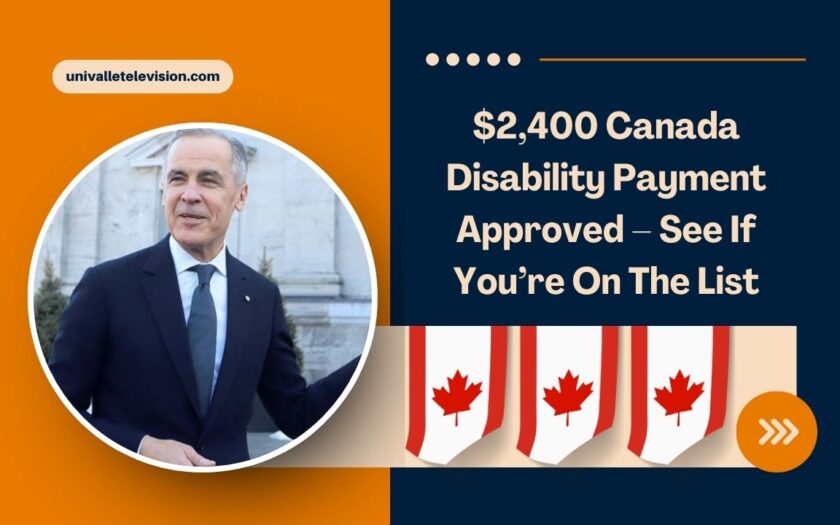In July 2025, the Canada Disability Benefit (CDB) will launch, offering up to $2,400 annually (or $200/month) to working-age Canadians with disabilities.
This tax-free support is designed to reduce poverty and enhance independence for individuals aged 18–64 who qualify for the Disability Tax Credit (DTC) and have low to moderate incomes.
Here’s a detailed guide on eligibility, benefit amounts, application process, and what you need to do to get ready.
What Is the Canada Disability Benefit?
The CDB is a new, federal monthly payment for non-senior adults with approved DTC, intended to supplement existing support programs.
It is part of a wider initiative under the Canada Disability Benefit Act (2023) and the Disability Inclusion Action Plan, reflecting Canada’s commitment to reduce poverty among people with disabilities.
Eligibility Criteria
To qualify for the CDB, you must meet these requirements:
- Aged 18–64
- Be a Canadian resident for tax purposes
- Hold one of: Canadian citizenship, permanent resident, protected person, or temporary resident (lived in Canada 18+ months)
- Approved for the Disability Tax Credit (DTC)
- Filed your 2024 income tax return (you and your spouse, if applicable)
Note: Recipients serving more than two years in federal prison are ineligible while incarcerated (with limited exceptions).
How Much Will You Get?
The maximum annual benefit is $2,400—or $200/month from July 2025 to June 2026. Adjusted for inflation from then on . The actual amount depends on your adjusted family net income (AFNI):
| Income Profile | Max Annual Benefit |
|---|---|
| AFNI ≤ $23,000 (single) | $2,400 |
| AFNI ≤ $32,500 (couple) | $2,400 |
| Exceeding thresholds | Gradual phase-out up to $45,000 (single) or ~$58,500 (couple) |
| Every $1 over threshold | Reduces benefit by $0.20 |
The plan includes a generous work income exemption—$10,000 for singles and $14,000 for couples —so moderate earnings won’t reduce your benefit.
Key Dates & Application Process
- Regulations finalized: June 2025
- Applications open: June 20, 2025
- Payments begin: July 2025 for applications approved by June 30; possible retroactive payments to June
- Application methods:
- Online via My Service Canada Account
- Paper form
- In-person, phone, or via community support services
After applying, you’ll receive a reference number and can track your status online.
Impact on Other Benefits
The CDB is non-taxable and will not reduce federal or provincial disability benefits. It acts as a top-up, not a replacement. However, it’s wise to confirm with your province’s disability office, as some may offset payments against provincial assistance.
Why It Matters
- Reduces poverty: Millions with disabilities currently live below the low-income cutoff, and this benefit offers critical relief.
- Promotes independence: The non-taxable monthly support helps with daily living costs and deepens financial security.
- Aligns with UN disability rights: Supports Canada’s commitment to the UNCRPD .
🇨🇦 With $6.1 billion allocated over six years (plus $1.4 billion annually), the CDB signals a serious federal commitment to supporting people with disabilities.
How to Prepare
- Secure your DTC—submit Form T2201 if not already applied.
- File your 2024 taxes (and spouse’s if applicable) before the deadline.
- Gather documentation: SIN, banking info, photo ID, tax slips.
- Monitor your mail—CRA may send you a letter.
- Apply in June 2025, then watch for payment starting in July.
The Canada Disability Benefit marks a historic step forward in supporting working-age Canadians with disabilities. With up to $2,400 annually, it provides significant, tax-free relief to those with limited income.
To access this benefit, ensure you’re approved for the Disability Tax Credit, file your 2024 tax return, and stay ready to apply when the portal opens in June 2025. For many, this payment will offer both financial stability and renewed independence.
FAQs
Does the CDB affect other benefits?
No. It’s non-taxable and does not affect most federal or provincial benefits.
Can I receive retroactive payments?
Yes—up to 24 months retroactive, but no earlier than July 2025.
Will the benefit phase out if I earn more?
Yes. AFNI above the threshold reduces your benefit by $0.20 for each extra dollar.

